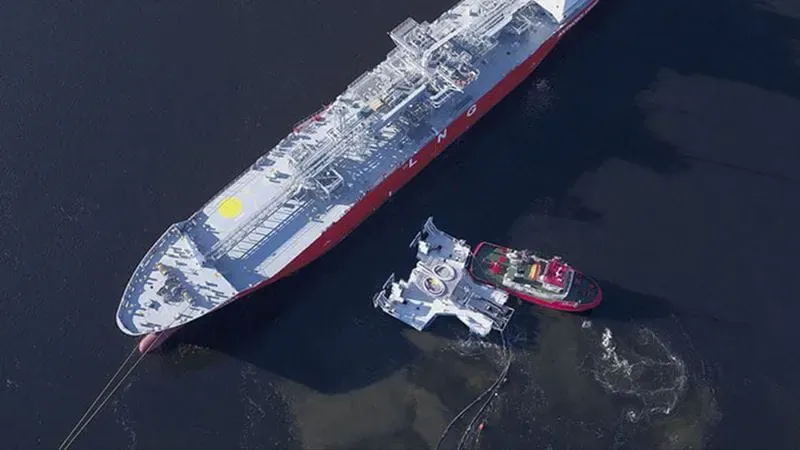Transferable terminals

The liquefied natural gas (LNG) industry thrives on new ways of doing things. As Ira Joseph, Head of Global Gas and Power Analytics at S&P Global Platts, recently wrote in the commodities bible Platts, “Breaking taboos in the LNG industry is a time-honored tradition.” This sentiment has underpinned Trelleborg’s work in the LNG infrastructure sector for many years. For LNG projects to succeed, they need to embrace fresh thinking when it comes to the transfer zone and to do things differently
from the fuels that have gone before.
This is more important than ever in view of the dynamics of the market, marked by rapid evolution. The long-term outlook for LNG appears healthy, but it’s not without complications. This means that there can be no letup in the pace of development of physical infrastructure that reduces both capex and opex for energy majors, terminal operators and others involved in the transport of LNG.
“LNG demand will only grow if the pricing point can be lowered, and it is the sellers that will need to foot the bill,” Joseph wrote. “Shaving down costs on delivery of LNG is necessary for gas to find a sustainable market.”
Few large terminals are set up to cater to smaller LNG carriers, a deficiency that suppliers hope to rectify by tapping underused floating storage and regasification units (FSRUs) anchored near areas of stranded demand.
“At the Gastech exhibition and conference last year, we saw how this is now coming together as the market adapts to these trends,” says Vincent Lagarrigue, Oil & Marine Director within Trelleborg Industrial Solutions. “There is a strong trend toward a more comprehensive chain of floating infrastructure. In addition to FSRUs, the idea of floating power plants is also becoming increasingly popular. Similarly, many existing FSRUs are being upgraded to handle smaller carriers and bunker barges. Overall, the cost advantages of floating infrastructure, as well as its inherent flexibility, are gaining prominence.”
Engineering, procurement and construction companies are now entering the small- and mediumscale LNG market as it matures into a fully comprehensive energy supply chain. With it, they are bringing global scale and expertise that is helping to develop best practices.
Suppliers are also playing a vital role in adopting new approaches to infrastructure development, reducing the cost of LNG transfer and accelerating deployment. With Trelleborg’s Cryoline hose technology, for example, it’s not only possible to conduct transfers that would otherwise not be feasible due to environmental concerns or remote locations, but also to adapt existing terminals to handle a wider range of vessels.
“Cryoline technology, when combined with a floating platform, makes it possible to bring infrastructure to the vessel,” Lagarrigue says.
“This reduces the need for extra construction, while also enabling transfer or bunkering in areas that would be otherwise unsuitable, such as locations that are too shallow for carriers, or too deep to construct a jetty. In addition, it allows transfer infrastructure to be relocated when out of use, down for maintenance or moved into port to avoid damage from adverse weather.” Significantly, the use of cryogenic hoses for LNG transfer also cuts down on the scale of the infrastructure required and allows for easier installation and decommissioning.
System provider for LNG transfer segment
The engineering group Signum Technology Ltd. has been part of the Trelleborg Group since summer 2019. Consisting of the companies Gall Thomson, KLAW LNG, Vee Bee Filtration and KLAW Products, it delivers safetycritical flow control solutions for the oil, gas and petrochemical industries, such as marine breakaway couplings and LNG transfer systems. The acquisition complements and extends Trelleborg’s product portfolio and strengthens Trelleborg as a system provider, primarily to the fast-growing LNG transfer market segment.
“We are very pleased to announce the acquisition of Signum,” says Jean-Paul Mindermann, President of the Trelleborg Industrial Solutions business area. “Combined, we are creating a very attractive offering of integrated packages and safety-critical systems for both LNG ship-to-ship and ship-to-shore transfer in demanding industries. Signum has a reputation for quality and innovation, very much like Trelleborg. This acquisition will also further strengthen our geographic coverage, notably in the aftermarket and service business – hence a really good fit for us in many respects.”
For more information, please go to:
https://www.trelleborg.com/en/fluidhandling
This is an article has been reproduced from Trelleborg's T-Time magazine. To download the latest edition, go to: www.trelleborg.com/t-time
Press Service: This article is available in eight languages. Media are welcome to use this article in their own publications. To download the article and pictures in any language go to https://bamboo-contentpartner.com/. If you reproduce information from this release, please give contact details as: www.trelleborg.com.